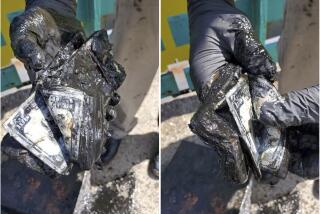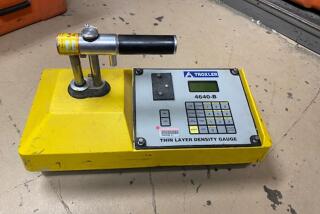13-year-old boy using metal detector finds 2-pound meteorite
- Share via
As the director of the University of New Mexico’s Institute of Meteoritics, Carl Agee gets tons of calls, packages and emails from people claiming to have had the rare experience of actually finding a meteorite.
Sadly for Agee, most are merely terrestrial rocks, what he calls meteor-wrongs.
Then he met 13-year-old Jansen Lyons. Two weeks ago, the teenager walked into the institute – his mother in tow – carrying what he said was a 2-pound hunk of space rock he found at an undisclosed location in the Albuquerque suburb of Rio Rancho.
Skeptical, Agee took a look-see. And sure enough, he confirmed this week, the lad had located a large “L6 ordinary chondrite” that Agee estimates had been on the ground for about 10,000 years.
Agee told the Los Angeles Times that after yelling and hurrahing, he told Lyons he had a sure-fire career as a scientist.
“Meteorites are rare – it’s difficult to find them. And usually where they’re located are in well-known localities, places where there are existing craters or strewn fields, so people know where to hunt for them,” Agee told The Times.
“But to find a meteorite on a hike using a homemade metal detector – not to mention being only 13 – is frankly quite extraordinary. But this kid is really bright. He’s home-schooled and he’s going to make a great scientist someday.”
Jansen found the meteorite last September. He told the Associated Press that he developed an interest in meteorites in 2008 after reading a book that belonged to his brother. Since then, his fascination skyrocketed so much his grandfather eventually designed and built him a metal detector to assist in his searches. Jansen now has three metal detectors.
“I’ve turned over every single rock in our backyard several times,” he told the AP.
But when he found the meteorite last year at a location the family does not want to disclose, he said, he knew he had something special. The rock has a unique fusion crust and a tell-tale black coating.
Meteorites are remnants of asteroids, or sometimes comets, that fall from the sky onto Earth’s surface. The one Jansen found is the second-most common type and is composed in part of nickel-iron metal.
He called the university meteorite institute, which had been closed for months, even though many people doubted the veracity of his find. “I promised my mom that if anyone tried to say it’s not a meteorite, I was going to prove them wrong,” he said.
Jansen is keeping the meteorite, although a small chunk will be displayed at the museum. “I think it’d be a really great shame to sell it,” he said.
Agee is still amazed this meteorite just dropped on his doorstep.
“It’s a nice-sized sample,” he said. “It’s not a boulder, but it’s not a bb-sized pebble either. It’s something you can hold in your hand.”
He said the rock will be named the Rio Rancho Meteorite.
Meteors are never named after their finders, he said. “Asteroids maybe, but meteorites are always named after their localities.”
He said he wasn’t sure whether Jansen was disappointed. “No matter what it’s called,” Agee said, “it’s quite a find.”
ALSO:
5 ways to avoid, or survive, an alligator attack
Terrified? NASA has reason to be when it comes to Mars landing
Colorado’s most destructive wildfire ever, Waldo Canyon, is contained
john.glionna@latimes.com
More to Read
Sign up for Essential California
The most important California stories and recommendations in your inbox every morning.
You may occasionally receive promotional content from the Los Angeles Times.













